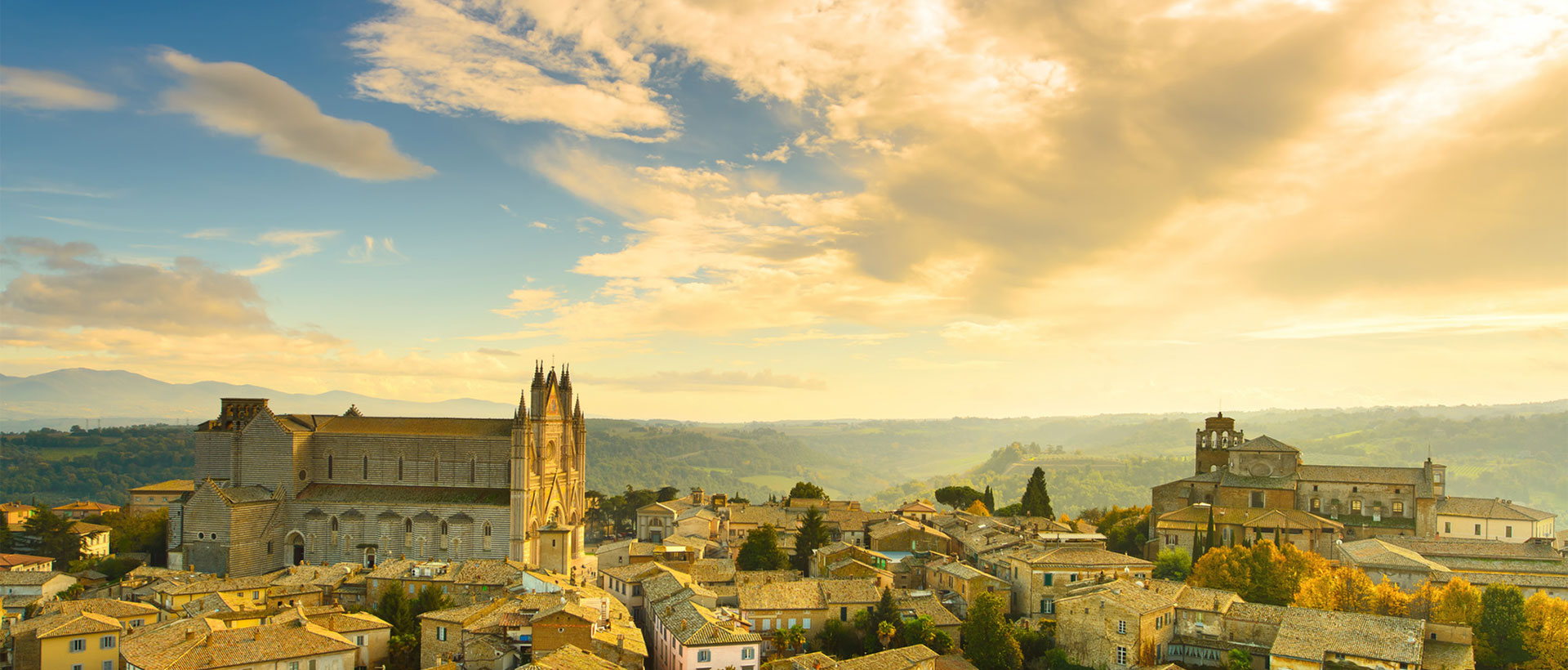Origins of Orvieto
Orvieto sits proud on a plug of volcanic rock, a natural fortress protected by steep cliffs and systems of caves. The origin of the gigantic tufa outcrop is most likely found in the thunderous eruption of the caldera volcano of nearby Lake Bolsena, 370,000 years ago. The lake was formed in a giant tectonic convulsion that flung giant rocks far away from the volcano itself, and one of these formed the naturally fortified hillock that some early settlers chose as their base. There are traces of the city’s origins and past, in particular in the old tufa rock and in the fossil trees recently discovered in various of the city’s caves.
Early settlers in Orvieto
This naturally fortified position has given Orvieto great prestige in several different historical periods. During the 9th Century BC the city was the most important town in the Etruscan lands.
Recently archaeologists have discovered, in an area below the cliffs, what they believe to be the “Fanum Voltumnae”: the Etruscan sanctuary thought to be the center of the Etruscan religion. Originally known as “Velzna”, the city of Orvieto was both the religious and political center, where the leading exponents of the 12 major Etruscan cities (dodecapoli) would gather.
Etruscan Stronghold
Archeologists continue to explore and dig in sites around the city; among their findings are the Crocifisso del Tufo necropolis, located on the side of the cliff overlooking Orvieto Scalo and Sferracavallo, and the remains of the Temple of Belvedere, near Piazza Cahen. In addition to these sites you can see many significant items in the collections housed in several local museums like the Archaeological museum or the Museo Faina (both placed in Piazza Duomo, next and front of the cathedral).
Roman invasion of Orvieto
The Etruscans inhabited Orvieto until the 3rd Century BC, when the Romans invaded “Velzna”. It took the Romans two years to conquer Orvieto, which is a natural fortress, with its cliffs on all sides. The Etruscans had dug an intricate web of caves and numerous wells, so they were able to defend Orvieto for a long time.
The Etruscans would have held out for longer, but the servants revolted and were able to seize power from their Etruscan owners. This led to the Etruscan aristocrats having to ask fro aid from the Romans, who sent an army to the city, led by the consul Quintus Fabius Maximus.The fighting was very hard and led to the death of the console itself, which then led to a violent Roman repression, and eventually to the destruction of the city in 264 B.C.
When the Romans eventually seized Orvieto, they “exiled” the few survivors to Volsinii Nova, today Bolsena, and unfortunately also destroyed most of the evidence of the Etruscan civilization.
The Romans used the area of Orvieto to supply crops, wine and other goods to Rome. Today there are few traces of the existence of the Roman civilization in Orvieto: Ponte Giulio (bridge) in Allerona Scalo and a recent discovery of the remains of a Roman harbor that was a very important trading route, Porto di Pagliano, located along the Paglia river – about a 10 minute drive from Orvieto. The original inhabitants of Orvieto, exiled to Bolsena, only managed to return to what was left of Orvieto after the end of the Roman Empire.
Medieval Orvieto
The Middle Ages were an important time for the city of Orvieto. It was a period of great wealth, beauty and expansion. In 1200 AC Orvieto became a modern, functional city-state, controlling the surrounding territories from the present-day town of Orbetello to the shores of the Tyrrhenian Sea.
In this period the city was called “Urbs Vetus” (old town), from which root the current name of Orvieto derives. During the Middle Ages Orvieto had a well organized political system and urban structure, distinguished by four districts: Serancia, San Giovenale, Postierla and Santa Pace.
Pope Urban IV stayed in Orvieto from October 1262 until September 1264, because of the civil war in Rome. He commissioned the construction of the Duomo to be built alongside his palace. The fountain in Piazza della Repubblica, Palazzo del Popolo and Palazzo dei Sette were also built during this time.

Orvieto and the Papal State
This period of wealth and prosperity lasted until the year 1348 when the plague, and constant political fighting among the great noble families (especially between Monaldeschi and Filippeschi, the most important noble family of Orvieto and surroundings) put an end to Orvieto being a free municipality and city-state.
From 1600 to 1700, the city found economic prosperity thanks to its popularity among popes and cardinals who considered it to be a quiet and safe place to stay not far from Rome. The development of the city partly initiated by the presence and attendance of high prelates and pontiffs was consolidated and found further impetus from 1860, when Orvieto became part of the Kingdom of Italy and the Savoy State becoming almost a frontier point between the latter and the Papal State itself.
Recent developments
The urban renewal of the city has continued: between 1800 and 1900, Orvieto experienced a period of restoration as well as works upgrading transport and communication infrastructure. In 1888 the first cable car (known as the Funicolare) was created and powered by an extraordinarily advanced water tank system. Today, the Funicolare (now electric) still connects the center of Orvieto with Orvieto Scalo (where the train station is located).
Where to stay near Orvieto
To visit this area, you could stay in Casa Umbra or Casa Carina, two villas with pools east of the city. Or in Villa Serra , a villa for 8 closer to Todi but still well placed to visit the city. To see all our houses in the area click here: Villas in Umbria
